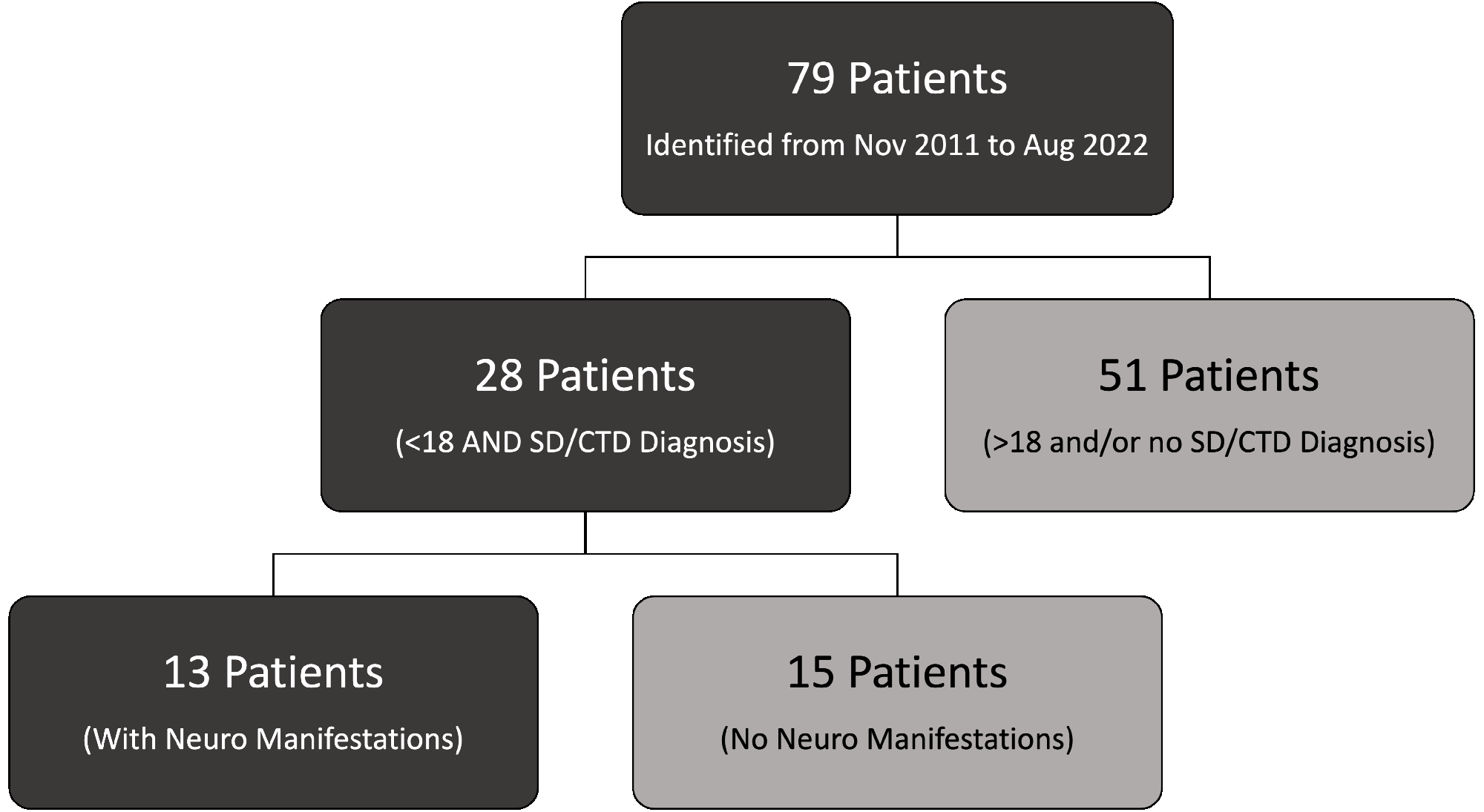Session Information
Date: Monday, November 13, 2023
Title: (1221–1255) Pediatric Rheumatology – Clinical Poster II: Connective Tissue Disease
Session Type: Poster Session B
Session Time: 9:00AM-11:00AM
Background/Purpose: The prevalence of Sjogren’s disease (SD) is becoming increasingly recognized in pediatric rheumatology. Despite fewer sicca symptoms, it has been shown that pediatric SD (pSD) patients experience neurologic manifestations at a rate higher than their adult counterparts. This case series aims to identify the neurologic manifestations and associated characteristics of pediatric patients with SD at a single academic institution.
Methods: Billing codes, age parameters, and encounter dates were used to identify patients diagnosed with SD prior to 18 years of age and seen between November 1, 2011 and August 15, 2022. 79 charts were initially identified (Figure 1). Charts were reviewed to confirm that patients had a diagnosis of pSD or connective tissue disease (CTD) with SD features. Set search terms were then applied to find patients who met inclusion criteria for neurologic manifestations. Patient demographics, serologies, neurologic manifestations, evaluation, and management were manually extracted. IRB approval was obtained for retrospective chart review.
Results: Twenty-eight pediatric patients were evaluated in the specified time frame and diagnosed with pSD/CTD. Thirteen of these patients (46%) had neurologic manifestations. Of these, 62% (8/13) had sicca symptoms and 77% (10/13) had arthralgia at diagnosis. 85% of patients with neurologic manifestations were female. 46% of patients were identified as white, 31% as black, and 23% as Hispanic/Latina/o/x. Additional demographic information and testing results can be found in Table 1. The most common neurologic manifestations in pSD patients were headaches and sensory changes, which occurred in eight patients (62%) and seven patients respectively (54%). Six of the eight patients with headaches were diagnosed with migraines, and four of the seven patients affected by sensory changes were diagnosed with small fiber neuropathy. Other diagnoses included mononeuritis multiplex (1/13), aseptic meningitis (1/13), recurrent Bell’s palsy (1/13), and mild neurocognitive disorder (1/13). All neurologic manifestations, timing with regard to pSD diagnosis, work-up, and treatments are in Table 2. For ~70% of patients (9/13), neurologic manifestations began prior to or at the time of their pSD diagnosis. For patients with symptoms occurring prior to pSD diagnosis, all symptoms occurred one or more years prior. Five patients (38%) had treatment regimen changes due to their neurologic manifestations. Adjustments included the addition or increase of glucocorticoids (4/13), the addition of rituximab (2/13), the addition of IVIg (1/13), and an increase in hydroxychloroquine dose (1/13).
Conclusion: Neurologic manifestations occurred in nearly half of pSD patients. Migraines and small fiber neuropathy, which are more frequently seen in SD patients, were the most common pSD neurologic manifestations. For pediatric patients with neurologic symptoms of unknown etiology and pediatric patients with other rheumatologic diagnoses, pSD should remain in the differential as a possible diagnosis to explain their neurologic symptoms.
To cite this abstract in AMA style:
Faison M, Lavallee C, McDonald J, Edens C. Neurologic Manifestations of Pediatric Sjogren’s Disease Patients: Case Series from an Academic Children’s Hospital [abstract]. Arthritis Rheumatol. 2023; 75 (suppl 9). https://acrabstracts.org/abstract/neurologic-manifestations-of-pediatric-sjogrens-disease-patients-case-series-from-an-academic-childrens-hospital/. Accessed .« Back to ACR Convergence 2023
ACR Meeting Abstracts - https://acrabstracts.org/abstract/neurologic-manifestations-of-pediatric-sjogrens-disease-patients-case-series-from-an-academic-childrens-hospital/



